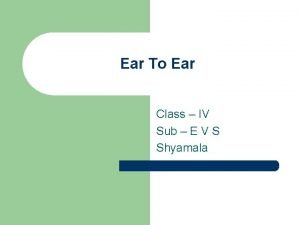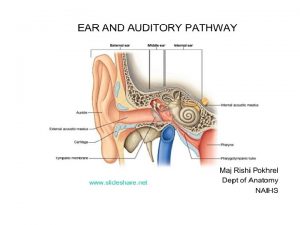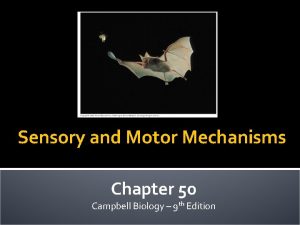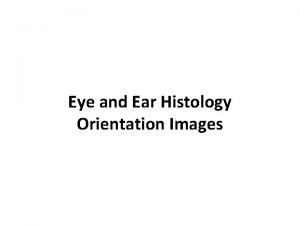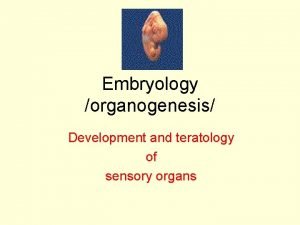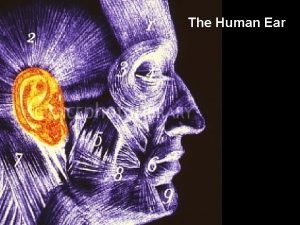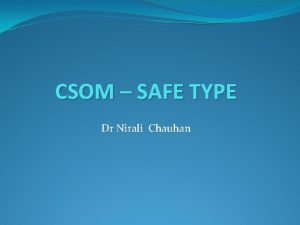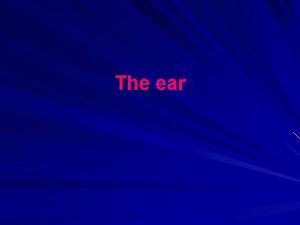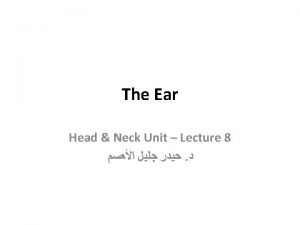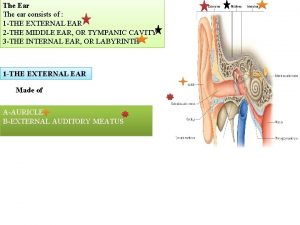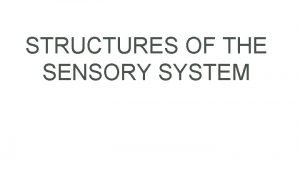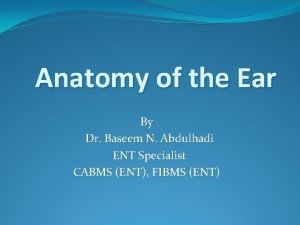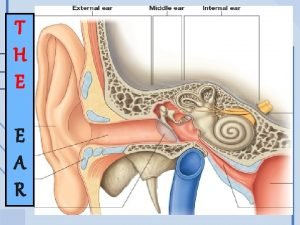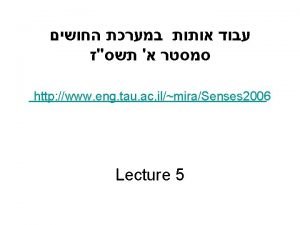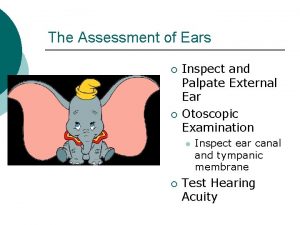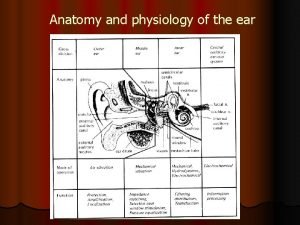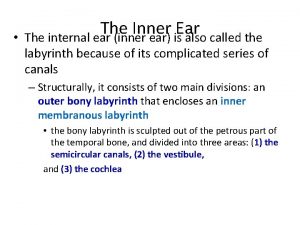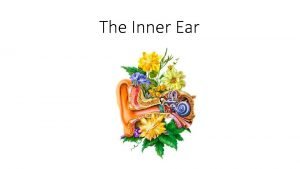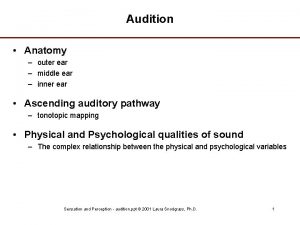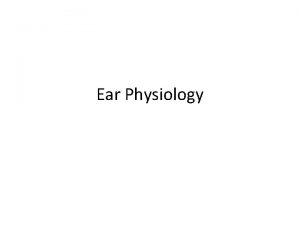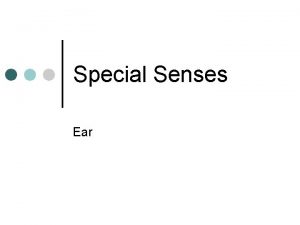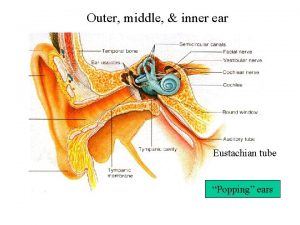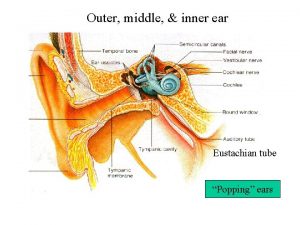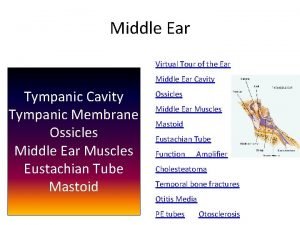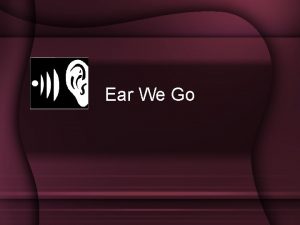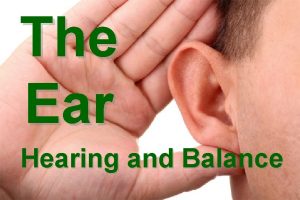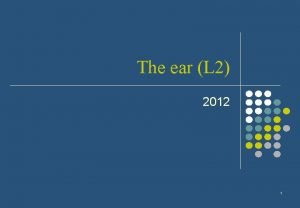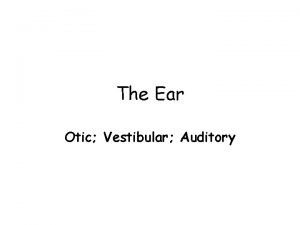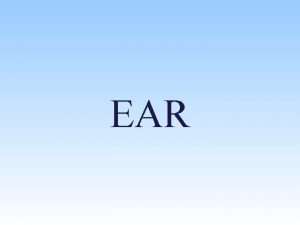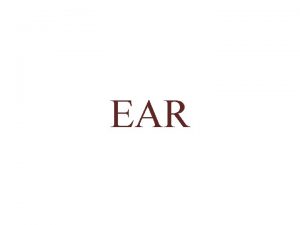The External Ear General Compartments External Middle Inner





















- Slides: 21

The External Ear

General Compartments • External • Middle • Inner


External Ear • Consists of: 1. Auricle / Pinna: yellow elastic cartilage except the lobule. 2. External Auditory Canal: • 24 mm in length • S – shaped (not straight) • 2 parts: • Cartilaginous Part: outer 1/3, skin contains ceruminous and pilosebaceous glands which secret wax, and hair follicles. • Bony Part: inner 2/3, skin is thin and continuous with outer layer of tympanic membrane.

External Ear (continued) 3. Tympanic Membrane: • Oblique, oval • 9 -10 mm tall, 8 -9 mm wide, 0. 1 mm thick. • Layers: 3 layers • Outer epithelial layer: continuous with the skin lining the ear canal • Inner mucosal layer: continuous with the mucosa of the middle ear. • Middle fibrous layer: more well- formed and organized in pars tensa. • 2 parts: • Pars Tensa: most of TM, periphery is thickened to form the annulus. • Pars Flaccida: above the lateral process of malleus


Cerumen • consists of desquamated epithelium mixed with the sebum produced from sebaceous glands and the watery secretions of modified apocrine sweat glands (apopilosebaceous unit) • acidic: bacteriostatic + fungostatic • contains lysozymes which are bactericidal

Nerve Supply • Anterior part: Auriculotemporal branch of mandibular branch of trigeminal (V) • Posterior and central part: auricular branch of Vagus Nerve (X), Facial nerve (VII) • Posterior and inferior part: cervical C 2, C 3 • Understanding innervation is important to understand referred ear pain

External ear Embryology: • Condensation of the mesoderm of the 1 st and 2 nd pharyngeal/brachial arches occurs to give rise to 6 hillocks of His • 20 th week gestation: It has reached adult shape • 9 years: reach adult size (this is the age of performing plastic surgery)

Congenintal anomalies of the Pinna • Preauricular tag • Remnant of one of the hillocks. • Uncertain risk factor for hearing loss. • Preauricular sinus • results from improper fusion of the 1 st & 2 nd brachial arches • May be associated with branchio-oto-renal syndrome • Surgery is only indicated when it is complicated by recurrent infection or abscesses • Microtia: underdeveloped ear pinna • Bat ears: protruding ears, loss of antihelix

Preauricular Tag

Trauma to the Auricle • Haematoma of the Auricle: • Collection of blood between the cartilage and its perichondrium. • A result of blunt trauma, e. g. boxers, wrestlers. • Extravasated blood may clot and organize resulting in “Cauliflower Ear” or “Boxers Ear” • Treatment: either repeated aspiration under aseptic precautions with pressure dressing or incision and drainage with pressure dressing and prophylactic antibiotics. Haematoma Cauliflower ear

Infections of the auricle • Erysipelas: • infection of the overlying skin • Caused by group A beta hemolytic strep. • Rapid treatment with oral or IV antibiotic • cellulitis (infection of the soft tissue) • Cellulitis of the ear typically results from a spreading otitis externa or a penetrating injury. • It is distinguished from perichondritis by the lack of induration • Rapid treatment with Anti-staph oral or IV antibiotic • Perichondiritis to chondritis : • represent infections of the auricular perichondrium or cartilage • Secondary to lacerations, haematoma, surgical incisions or piercings. Or as an extension from diffuse otitis externa. • infection involving the cartilage itself of the auricle & external auditory canal. • The lobule, which contains no cartilage, is spared • Most common cause is Pseudomonas aeruginosa and mixed flora. • Treament: systemic and local antibiotics. In case of abscess formation, it must be drained promptly and treated with systemic and local antobiotics.

Relapsing Polychondritis • Auto-immune disease • Other cartilages may be involved like septal, laryngeal, tracheal and costal cartilages. • presentation: • acute phase: fever • sudden sever painful uniform swelling and erythema of the auricle • Chondritis rapidly develops and resolves in 5 -10 days • Spares: external auditory canal, lobule

Inflammations of Ear Canal

External auditory canal infections • Furunculosis • Furuncle is a localized abscess of the apopilo-sebaceous unit • Most common organism: Staph aureus. • Confined to the outer 1/3 of the ear canal. • Symptoms: severe pain and tenderness. • Treatment: • Analgesia • Anti-staphylococcal oral and topical antibiotics should be administered. • A fluctuant lesion should be incised and drained under local anesthetic.

Otitis externa • Diffuse swelling of the meatal skin which may spread to the pinna and epidermal layer of the tympanic membrane. • Approximately 80% of cases occur in the summer, particularly in warm, humid environments. • Other predisposing factors include anatomic obstructions of the ear canal (e. g. , stenosis, impacted cerumen), hearing aid or ear plug use, self-induced trauma (e. g. , by cotton swabs), and swimming, secondary to chronic middle ear discharge. • Common pathogens: Staph aureus, Pseudomonas pyocyaneus, Bacillis proteus, E coli but more often the infection is mixed. • Symptoms: hot, burning sensation in the ear, pain, discharge, inflamed swollen meatal skin. Treatment : 1. 2. 3. 4. 5. Frequent aural toileting Local and systemic antibiotics Medicated ear wicks/packs Analgesics Avoid water contact

Fungal otitis externa (otomycosis) • Aspergillus accounts for 80 -90 % of cases with Candida being responsible for the remaining 10 -20%. Aspergillus • In hot, humid climates. • Secondary fungal growth is also seen in patients using topical antibiotics for treatment of otitis externa or middle ear suppuration. • Presentation: intense itching, discomfort or pain in the ear, watery discharge with a musty odour and ear blockage. The fungal mass may appear white, brown or black and has been likened to a wet piece of filter paper. Treatment : 1. Frequent aural toileting 2. Local antifungal 3. Avoid water contact Candida

Malignant (Necrotizing) otitis externa • Malignant Otitis Externa: otitis externa + osteomyelitis of the tympanic plate of the temporal bone which may extend to involve skull base • Clinical Presentation: • Persistent Otalgia more than 1 month • Persistent Otorrhea with granulation tissue • Persistent Otorrhea in the immunocompromised patients (Diabetics with microangiopathy and cellular immune dysfunction), HIV. • Deep-seated aural pain (pain out of proportion to examination findings). • Facial nerve palsy and multiple lower cranial nerves palsy. • Most cases are caused by P. aeruginosa • Diagnostic: • CT scan with IV contrast • MRI • Gallium-67 and Technetium-99 m bone scanning

Malignant (Necrotizing) otitis externa Treatment: • • • Regular aural toilet Blood sugar control Correct immunodeficiency if possible Pain killer Infectious disease consult IV antibiotic for 6 -8 weeks, with antipseudomonal coverage (gentamicin+ticarcillin or ceftazidime+aminoglycoside or quinolones like ciprofloxacin) Prognosis: • Mortality is 5 -20%

Herpes Zoster Oticus • prodrome of otalgia, which may be severe. • A vesicular eruption is seen in the canal and concha. • Ultimately, these vesicles rupture and form crusts. • Etiology: • After primary infection (chickenpox), varicella-zoster virus is harbored in a latent state in sensory ganglia, and reactivates with infection spreading along dermatomes. • Harbored in the facial nerve VII and the vestibular ganglia of VIII • A subgroup of patients manifest Ramsay Hunt syndrome: SNHL, tinnitus or vertigo or both, Palsy: lower motor neuron palsy of the ipsilateral facial nerve • 2 nd commonest cause of lower facial nerve palsy after bell's palsy (9%) • Prognosis for facial nerve recovery worse than Bell’s palsy (only 60% regain normal function, where as up 90% regain normal function in bell’s palsy). • Symptoms: • Auricular pain: the 1 st symptom to appear • Vesicular Rash: location: concha, EAC, mucosa of the palate, anterior 2/3 of the tongue • Treatment: • acyclovir or valacyclovir • High-dose steroids • Corneal protection
 Inner defender and inner guide examples
Inner defender and inner guide examples Animals whose ears cannot be seen
Animals whose ears cannot be seen Two animals whose ears cannot be seen
Two animals whose ears cannot be seen Helical crus
Helical crus Ear inner structure
Ear inner structure Cochlear duct
Cochlear duct Lens placode
Lens placode U
U Inner critic and inner defender
Inner critic and inner defender Dr nirali patel
Dr nirali patel Petrositis
Petrositis Fenestra vestibuli
Fenestra vestibuli Middle ear
Middle ear Middle ear ossicles
Middle ear ossicles Semicircular canals function
Semicircular canals function Paralsy
Paralsy Tegmen tympani
Tegmen tympani Ear model
Ear model Rinne test method
Rinne test method Nerve supply of external ear
Nerve supply of external ear Physiology of external ear
Physiology of external ear Titanic watertight compartments diagram
Titanic watertight compartments diagram


